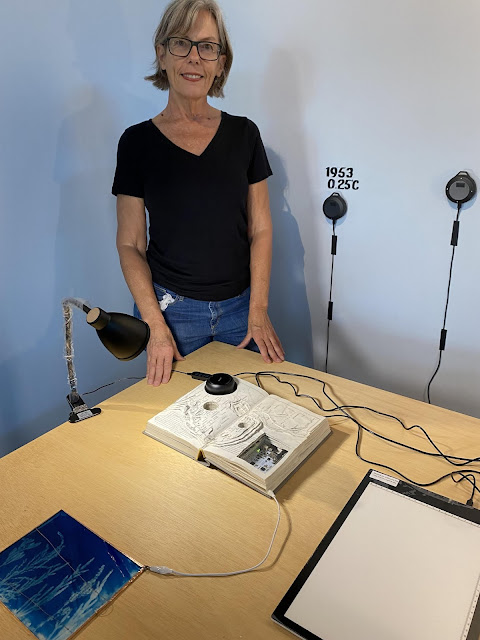By Lonnie Burstein Hewitt. Photos by Maurice Hewitt.
 |
| Saturday Night, 11/6/21: The nine performers in Everyday Dances, with John Malashock on the right. |
In September, the Mingei International Museum had its grand re-opening, but I never got to see a performance in its new theater space until last weekend, when John Malashock, Founder and Artistic Director of Malashock Dance, brought his Everyday Dances there.
Malashock, who founded his company in 1988, has had a distinguished career as performer and choreographer, and invited five other local choreographers to join him in presenting a program of 10 short pieces at the Mingei, one from each of them, and five of his own.
Why the title? "It's a riff on the Mingei's name, which comes from the Japanese word meaning 'art of the people' or art from everyday objects," he said. "The idea is taking the everyday and making art out of it. Each piece runs between three and seven minutes-short is good these days-and each has its own style, so there's a broad range of artistic voices. The program is only an hour long, but it gives an idea of what's going on in the wider dance community here."
The dances certainly brought the theater to life. A former loading deck, it's now a flexible space that can seat up to 120, but only offered seating for 60 at Everyday Dances to give the performers more room to move. It was a delight to feel close-but not too close-to the dancers, and to share a sense of spaciousness with the masked but obviously delighted audience.
The hour-long program opened and closed with pieces by Malashock-the first quite appealing, and the last quite dramatic-but every one of the ten dances had its own tone and style, and its own special appeal. "They're wonderful small-cast works, created in the spirit of the everyday, because we work every day," Malashock said in his introduction to the performance.
The five guest choreographers-Blythe Barton, Ryan Orion Beck, Lauren Christie, Marcos Duran, and Odessa Uno--all offered distinctive pieces, and the pieces all fit together beautifully. Two of the choreographers-Lauren Christie and Marcos Duran-also danced in their own works. All the dancers were top-flight, and it was no surprise that all three performances were sold-out.
Everyday Dances also gave us a chance to admire the dancers' backdrop-the unusual curtain by Amsterdam-based designer Petra Blaisse, who was inspired by San Diego's jacaranda trees. Made of double-sided dyed felt cutouts, backed with a layer of sheer silk organza, it let in a just a bit of light from the streetlamps outside the glass wall of the theater, creating a softly mystical mood for the Saturday night performance.
 |
| Detail of the curtain by Petra Blaisse. |
There will be a second weekend of Everyday Dances November 19-21 at Malashock Dance Studio Theater in Liberty Station. Tickets range from $10-35 for Friday and Saturday evenings, and the Sunday matinee is pay what you can. For details, go to Malashock Dance Everyday Dances
The Mingei is open Saturday-Wednesday 10 am-5 pm, Thursday and Friday 10 am-8 pm. with new exhibitions coming soon. Admission ranges from free to $18, with the Commons Level free to all, and Artifact Restaurant opening for lunch and drinks starting November 17.
Lonnie Burstein Hewitt is an award-winning author/lyricist/playwright who has written about arts and lifestyle for the La Jolla Light and other local media for over a dozen years. You can reach her at hew2@sbcglobal.net.






























































